What Is Arithmancy and Why Does It Matter?
Arithmancy is the ancient practice of divination using numbers, combining the Greek words “arithmos” (number) and “manteia” (divination). This mystical art transforms letters into numbers to reveal hidden meanings about personality, relationships, and future events.
Quick Answer for Arithmancy:
- Definition: Number-based divination system dating back to ancient Greece
- Methods: Converting letters to numbers using established charts
- Purpose: Predicting future events and understanding personality traits
- Modern Use: Personal growth, compatibility analysis, and self-findy
- Key Numbers: Character Number (full name), Heart Number (vowels), Social Number (consonants)
Whether you know it from Hermione Granger’s favorite Hogwarts subject or you’re curious about real-world numerology, arithmancy bridges the gap between mathematics and mysticism. As Hermione once said, “Oh no, it’s wonderful! It’s my favourite subject!” – and for good reason.
The practice involves three main steps:
- Assign numbers to letters using ancient charts
- Add the numbers together and reduce to single digits
- Interpret the meanings for insight and guidance
Unlike crystal ball gazing or tea leaf reading, arithmancy follows precise mathematical rules. This makes it appealing to people who want structured, repeatable methods for exploring life’s deeper questions.
I’m Oracle, and I’ve spent years studying the intersection of ancient numerological practices and modern self-findy techniques, including extensive research into arithmancy’s historical roots and practical applications. My work focuses on making these powerful tools accessible to anyone seeking clarity about their path forward.
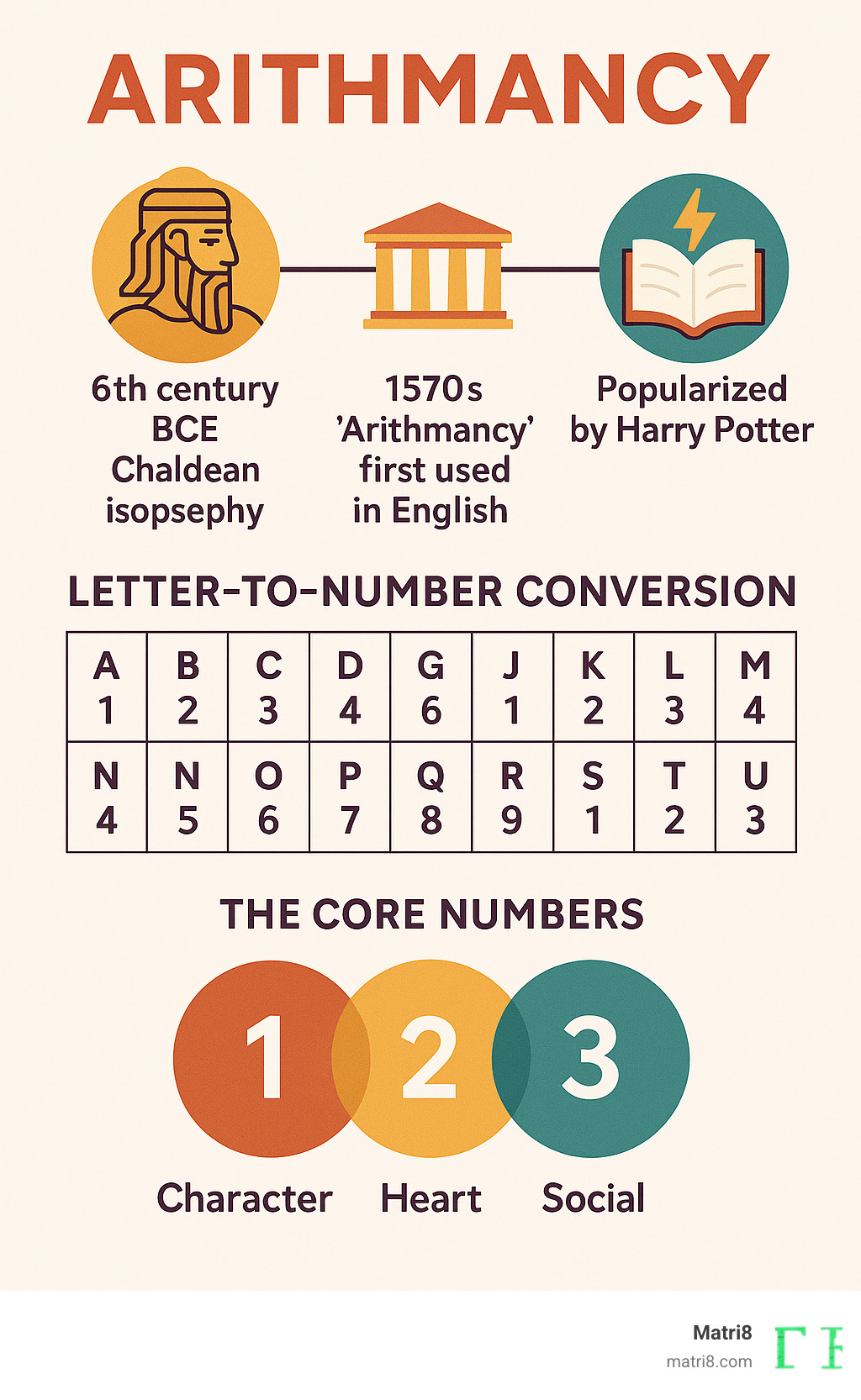
What Is Arithmancy?
Picture this: you’re sitting in a dusty library, surrounded by ancient texts filled with mysterious symbols and numbers. That’s exactly where arithmancy began its journey over 2,000 years ago. This fascinating practice combines the Greek words “arithmos” (meaning number) and “manteia” (meaning divination) to create something truly special – the art of finding meaning through mathematics.
The English word “arithmancy” didn’t show up until the 1570s, when King James I wrote about it in his 1597 work “Daemonologie.” He grouped it with other mystical arts that people used to peek into the future. But long before King James ever put pen to paper, ancient civilizations were already busy turning letters into numbers and numbers into wisdom.
Think of arithmancy as a bridge between the logical world of mathematics and the mysterious field of divination. Practitioners believe that every letter carries a numerical vibration, and when you add up these numbers from names or words, you open up hidden truths about personality, relationships, and what might lie ahead.
The ancient Greeks had their own version called isopsephy, while Hebrew scholars developed gematria – both clever ways of giving letters numerical values for spiritual insight. And we can’t forget Pythagoras, that brilliant mathematician who declared that “the entire universe is governed by numbers.” His ideas still influence how we practice arithmancy today.
| System | Origin | Method | Primary Use |
|---|---|---|---|
| Arithmancy | Ancient Greece/England (1570s) | Letter-to-number conversion for divination | Personality analysis, future prediction |
| Numerology | Modern term for various systems | Multiple calculation methods | Personal insight, life guidance |
| Gematria | Hebrew tradition | Hebrew alphabet numerical values | Religious/mystical interpretation |
Arithmancy vs Numerology
Here’s where things get a bit tricky – people often mix up arithmancy and numerology like they’re identical twins. They’re more like close cousins who share the same grandfather.
Arithmancy is the traditional name that honors the ancient roots of number divination. When you say “arithmancy,” you’re connecting to thousands of years of mystical tradition and historical practice. It’s like using the original recipe passed down through generations.
Numerology is the modern umbrella term that covers all sorts of number-based systems for personal insight. It’s broader and more flexible, adapting ancient wisdom for today’s world.
Both practices use two main systems that are worth knowing about. The Pythagorean System maps letters A through Z to numbers 1 through 9 in a repeating pattern – so A equals 1, B equals 2, and when you reach I (which equals 9), you start over with J equaling 1 again. It’s straightforward and popular.
The Chaldean System takes a different approach, assigning numbers based on sound vibrations rather than alphabetic order. Some practitioners swear this method captures more authentic spiritual energy, though it’s a bit more complex to learn.
Both of these differ from the ancient gematria and isopsephy systems, which stick to their original Hebrew and Greek alphabets respectively.
Core Arithmancy Numbers
Modern arithmancy focuses on three key numbers that paint a complete picture of who you are. Think of them as three different lenses for viewing your personality.
Your Character Number comes from adding up every letter in your full birth name, then reducing it to a single digit. This number reveals your core personality and life purpose – it’s like your spiritual fingerprint that shows what you’re here to accomplish.
The Heart Number focuses only on the vowels in your name. These letters represent your inner world – your deepest desires, emotional needs, and what truly motivates you when nobody else is watching.
Your Social Number uses just the consonants, showing how the outside world sees you. It’s your public face, the impression you make on others, and how you naturally interact in social situations.
Now, here’s where things get interesting. Master Numbers like 11, 22, and 33 don’t get reduced to single digits because they carry special spiritual significance. If your calculations result in these numbers, you’ve hit the numerological jackpot – they represent heightened spiritual potential and life lessons.
The digital root process is your mathematical tool for getting to these final numbers. You keep adding digits together until you reach a single number, unless you encounter those special master numbers along the way.
A Brief History of Number Magic
The fascinating story of arithmancy begins thousands of years ago with the ancient Chaldeans, who saw numbers everywhere in the cosmos. They cleverly divided their alphabet into three groups of seven letters, linking each group to one of the seven planets they could see in the night sky. This wasn’t just math – it was their way of connecting earthly words to celestial power.
The ancient Greeks took number magic in a surprisingly practical direction. Before heading into battle, Greek warriors would calculate the numerical values of their opponents’ names to predict who would win. Whoever had the higher total was expected to emerge victorious. Imagine settling disputes with math instead of swords!
Around 529 BCE, Pythagoras and his followers turned number mysticism into a serious philosophy. The famous mathematician didn’t just find geometric theorems – he taught that numbers were literally the building blocks of reality itself. His school developed many of the digit reduction techniques that modern arithmancy practitioners still use today.
During medieval times, Islamic alchemist Jabir ibn Hayyan blended numerical systems into his laboratory experiments. He believed that finding the right combination of numbers could open up the secrets of changing matter. This fascinating mix of science and mysticism influenced European occult traditions for centuries to come.
The wizarding world has its own numerical pioneer: Bridget Wenlock made her mark in the 13th century by finding the magical properties of the number seven. Her work bridges the gap between fictional magic and real-world number symbolism that still captivates us today.
Interestingly, our modern fascination with angel numbers – those repeating sequences like 111 or 444 – only started in 2004. However, their creator later changed her mind about the concept in 2024, showing how even number magic evolves over time.
For those wanting to dive deeper into these historical connections, Pathfinder Campaign Setting: Occult Mysteries offers detailed information about various mystical practices including arithmancy.
Arithmancy at Hogwarts and Beyond
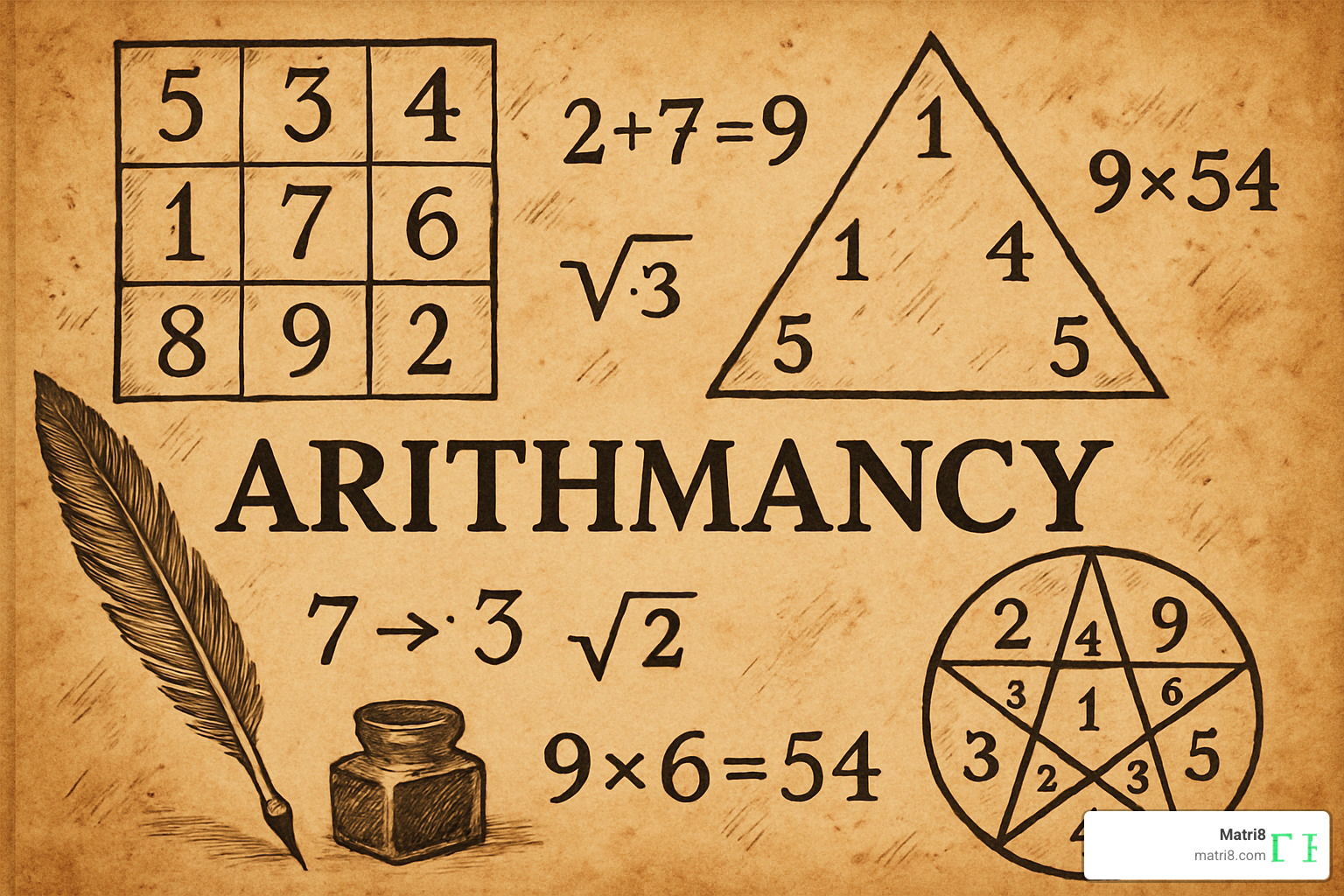
When J.K. Rowling created Hogwarts School of Witchcraft and Wizardry, she made arithmancy one of the most practical and challenging elective subjects available. Students can choose this course starting in their third year, though it’s definitely not for everyone – the subject requires serious mathematical thinking and precise calculations.
Professor Septima Vector teaches arithmancy in Classroom 7A on the seventh floor, where the walls are covered with complex numerical charts and equations. Students spend their time learning to create and interpret these charts, which wizards use to predict future events and understand magical patterns.
The main textbook, “Numerology and Grammatica,” introduces students to the basics of magical number work. Advanced students might also study “New Theory of Numerology” – you might remember this as the book Harry gave Hermione for Christmas in 1995, showing just how much she loved the subject.
What makes arithmancy so valuable in the wizarding world is its real-world applications. If you want to become a Curse-Breaker at Gringotts Wizarding Bank, you need to pass your arithmancy O.W.L. This makes sense when you think about it – those ancient magical vaults are protected by numerical locks and mathematical spells that require serious number skills to crack safely.
Hermione Granger absolutely loved arithmancy, and it’s easy to see why. As she put it, the subject offers “a very precise, measurable and almost scientific method of predicting the future.” For someone who preferred facts over guesswork, arithmancy was much more appealing than the vague interpretations required in Divination class.
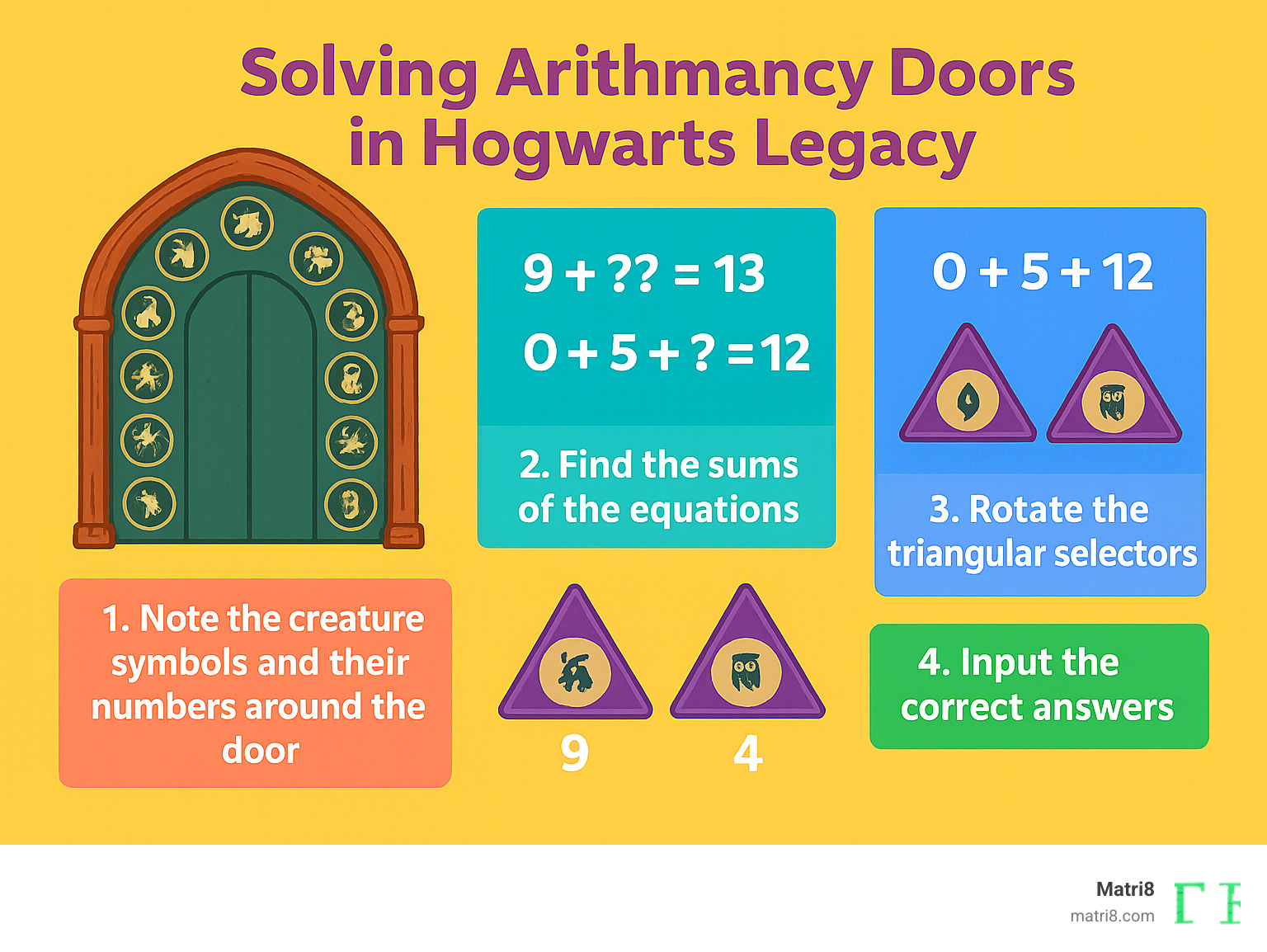
Solving Arithmancy Doors in Hogwarts Legacy
The popular video game Hogwarts Legacy brings arithmancy to life through 12 puzzle doors scattered throughout the castle. These doors challenge players to solve mathematical equations using magical creature symbols – and they’re actually quite fun once you get the hang of them!
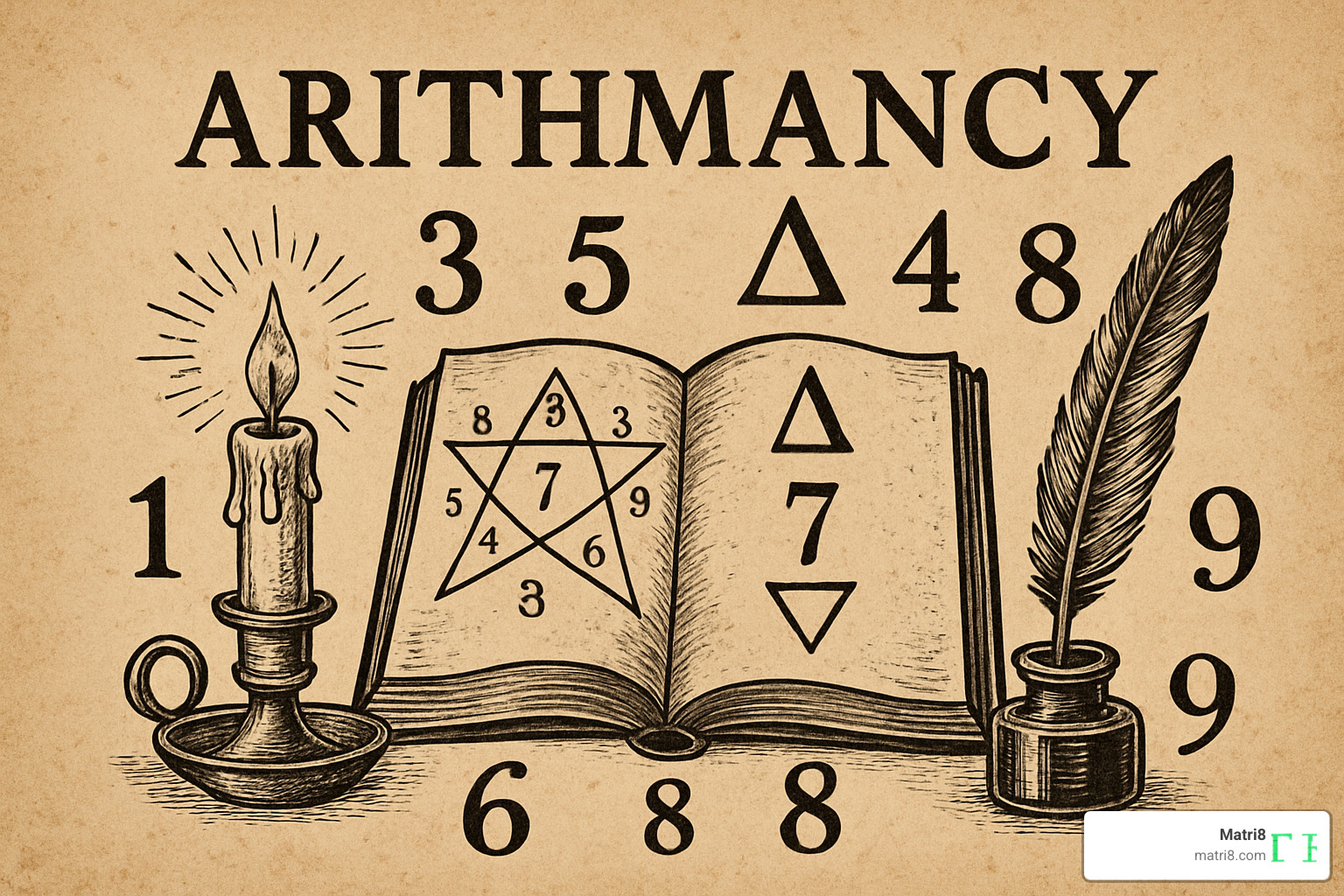
Your first stop should be the Library Annex to find the crucial cipher note. Head to the Divination Classroom Floo Flame and look for a small blue chest next to the blackboard. Inside, you’ll find the key to understanding which magical creatures represent which numbers.
The creature-to-number system is actually quite logical. Around each door frame, you’ll see ten different magical creatures arranged clockwise, representing numbers 0 through 9. The Demiguise represents 0, the Unicorn is 1, the Dragon is 2, and so on up to the Hydra at 9.
Each puzzle presents you with mathematical equations where some numbers are missing. Your job is to figure out what creatures should fill the empty spots to make the math work. The three outer symbols need to add up to equal the central number through addition or subtraction.
Here’s the trick that makes these puzzles much easier: you don’t need to memorize the entire cipher! The creatures are always numbered 0-9 clockwise around each door frame, so you can just count to find the right symbol.
Quick tips for success: Start with the central number and subtract the known values to find what’s missing. Double-check your work by adding all three outer numbers to confirm they equal the center. Each solved door rewards you with valuable gear and treasure chests, making the effort worthwhile.
Famous Wizarding Arithmancers
The wizarding world has produced some remarkable arithmancy experts throughout history, each using their number skills in fascinating ways.
Bridget Wenlock stands out as the pioneer of magical number theory. Back in the 13th century, she made the groundbreaking findy about the number seven’s special magical properties – research that still influences magical practice today.
The Weasley family produced two notable arithmancy students. Both Bill and Percy Weasley earned twelve O.W.L.s, showing their mastery of this challenging subject among others. Bill put his arithmancy skills to practical use as a Curse-Breaker, where understanding numerical magical protections was essential for his dangerous work with ancient Egyptian tombs.
Even Tom Riddle (later known as Voldemort) likely studied arithmancy during his time at Hogwarts. Some scholars believe he chose this elective specifically to harness the power of the number seven, which he later used extensively when creating his seven Horcruxes.
Murphy McNully from Hogwarts Mystery shows how arithmancy applies to everyday magical life. He uses numerical calculations to predict Quidditch match outcomes and analyze student behavior patterns – proving that number magic isn’t just for ancient curses and treasure vaults.
Professional Curse-Breakers at Gringotts represent the most practical application of arithmancy in the modern wizarding world. These specialists must master complex numerical systems to safely steer the mathematical locks and magical protections that guard the bank’s most valuable treasures.
How to Practice Arithmancy in the Real World
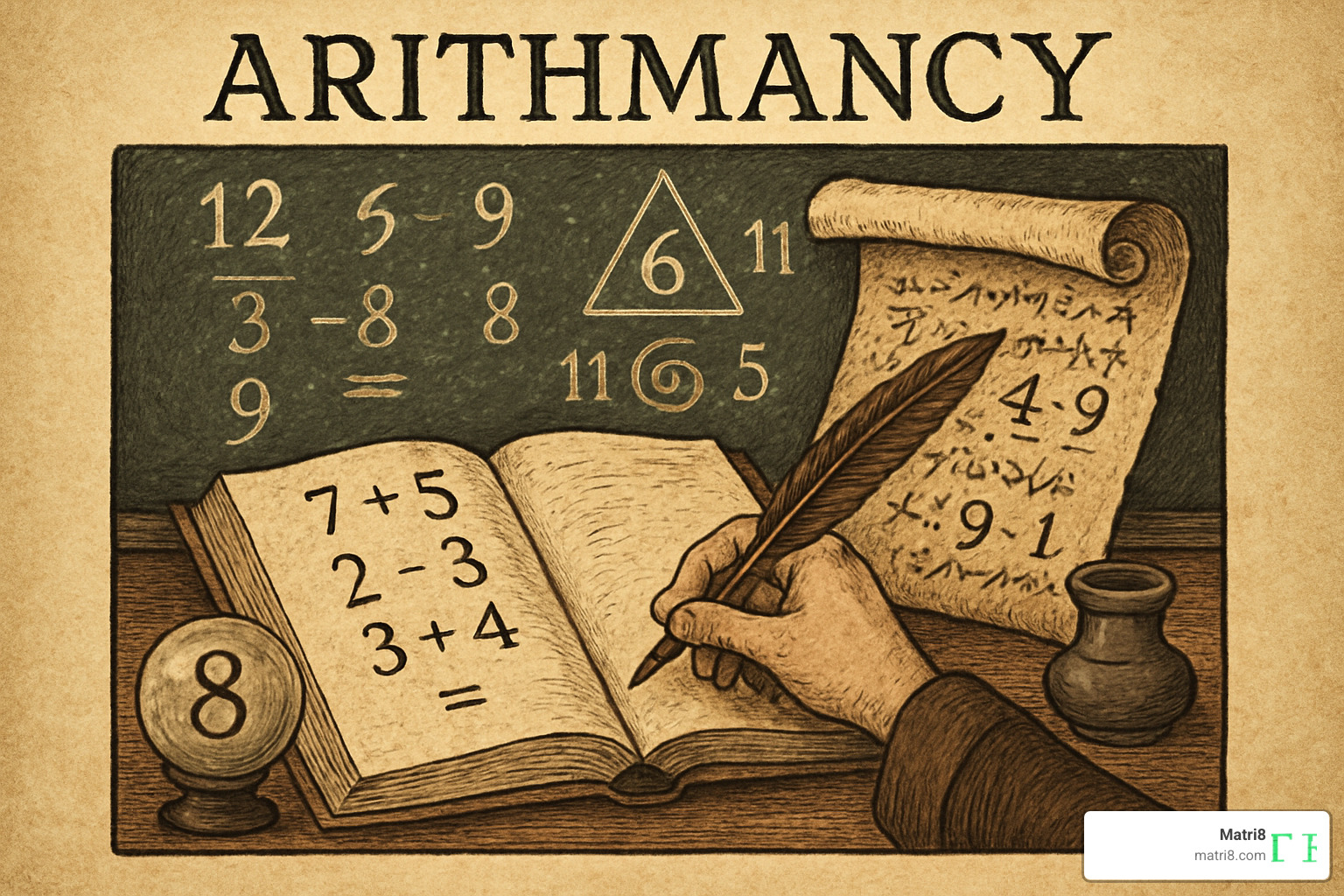
Want to try arithmancy for yourself? You don’t need a wand or magical ability – just a pen, paper, and basic math skills. The beauty of this ancient practice lies in its simplicity and the surprising insights it can reveal about your personality and life path.
The most popular method today uses the Pythagorean chart, where letters A through Z get assigned numbers 1 through 9 in a repeating pattern. Think of it like a number wheel that keeps cycling: A=1, B=2, C=3… all the way to I=9, then it starts over with J=1, K=2, and so on.
Some practitioners prefer the Chaldean chart, which assigns numbers based on sound vibrations rather than alphabetical order. Both systems have their merits, but we’ll focus on the Pythagorean method since it’s easier for beginners and has been used successfully for over 2,000 years.
The process reveals three key aspects of your personality: your destiny (shown by your full name’s Character Number) and your personality (revealed through the Heart and Social Numbers). Many online calculators can do the math for you, but understanding the manual process helps you appreciate the ancient wisdom behind each calculation.
For deeper insights into how these numbers connect to your life journey, you might want to explore Understanding Life Path Numbers, which looks at how your birth date adds another layer to your numerical profile.
Step-by-Step Calculation Guide
Let’s walk through the process using everyone’s favorite Hogwarts student, Hermione Granger, as our example. This hands-on approach will show you exactly how arithmancy transforms names into meaningful numbers.
First, write your name clearly – we’ll use “Hermione Granger” for our demonstration. Then assign numbers to each letter using the Pythagorean system: H=8, E=5, R=9, M=4, I=9, O=6, N=5, E=5, G=7, R=9, A=1, N=5, G=7, E=5, R=9.
Next, sum and reduce these numbers. Adding them all together gives us 94. Since we need a single digit, we add 9+4 to get 13, then 1+3 to reach our final answer of 4. This process is called finding the digital root – you keep adding until you get a number between 1 and 9 (unless you hit 11, 22, or 33, which are special master numbers).
Hermione’s Character Number of 4 perfectly matches her practical, organized, and hardworking nature. It’s fascinating how the numbers seem to capture personality traits so accurately!
You can also calculate separate numbers for vowels only (Heart Number) and consonants only (Social Number). Hermione’s vowels (E,I,O,E,A,E) add up to 31, reducing to 4, while her consonants total 63, reducing to 9.
If you’re curious about how birth dates factor into numerical analysis, check out Understanding Birth Date Numerology: Open uping the Power of Your Date of Birth for a complete picture of your numerical profile.
Interpreting Your Numbers
Once you’ve calculated your numbers, the real magic begins – understanding what they mean for your life and relationships. Each number from 1 to 9 carries distinct personality traits and life themes that have been recognized across cultures for thousands of years.
Number 1 people are natural leaders with independent spirits and pioneering energy. They’re the ones who start new projects and aren’t afraid to go first. Number 2 individuals seek harmony and cooperation, making them excellent diplomats and team players who smooth over conflicts.
Number 3 brings creativity and self-expression, often showing up in artists, writers, and entertainers who light up any room they enter. Number 4 represents Hermione’s practical, organized nature – these are the reliable people who get things done and build solid foundations.
Number 5 craves trip and freedom, constantly seeking new experiences and resisting routine. Number 6 nurtures others naturally, taking responsibility for family and community with genuine care and compassion.
Number 7 dives deep into analysis and spirituality, preferring quiet contemplation to loud parties. Number 8 focuses on material success and business achievement, with natural leadership abilities in the professional world. Number 9 accepts humanitarian causes with generous wisdom, seeing the bigger picture of how to help others.
Master numbers like 11, 22, and 33 carry heightened spiritual potential but also greater challenges. These numbers aren’t reduced further because they’re considered to hold special power and responsibility.
When it comes to relationships, comparing Character Numbers between people can reveal compatibility patterns. Numbers that complement each other – like creative 3 with nurturing 6 – often form strong partnerships because they balance each other’s strengths and weaknesses.
For a deeper dive into how different numbers interact in relationships, our guide on Numerology Compatibility explores the fascinating dynamics between various number combinations and what they mean for lasting connections.
The Power and Symbolism of Numbers

Numbers have fascinated humans for thousands of years, and for good reason. They show up everywhere in nature, religion, and even our daily superstitions. When you start practicing arithmancy, you’re tapping into this ancient wisdom that spans cultures and centuries.
Take the number seven, for instance. It’s everywhere you look – seven days of the week, seven colors in the rainbow, seven musical notes, seven chakras. In the wizarding world, Bridget Wenlock finded that seven held special magical properties. This wasn’t just fantasy – seven has been considered mystical since ancient times.
Then there’s thirteen, which makes people nervous even today. Hotels skip the thirteenth floor, airlines avoid row 13, and Friday the 13th still gives people the jitters. This superstition runs so deep that there’s actually a word for fear of the number 13: triskaidekaphobia.
The number 666 carries heavy weight in Christian tradition as the “Number of the Beast.” This shows how arithmancy and religious interpretation have been intertwined throughout history. Numbers aren’t just mathematical tools – they’re symbols that carry emotional and spiritual meaning.
Even modern scientists get caught up in number mysticism. The physicist Wolfgang Pauli was obsessed with 137, known as the fine structure constant. He spent years trying to understand why this particular number seemed to govern fundamental forces in the universe. Paul Dirac had similar fascinations with cosmic numerical relationships.
What’s interesting is how number meanings change across cultures. While the number 4 represents stability and hard work in Western numerology, many Asian cultures consider it unlucky because it sounds like their word for “death.” This reminds us that number symbolism is both universal and deeply personal.
Science, Skepticism, and Mysticism
The relationship between numbers and meaning isn’t always straightforward. Some legitimate scientific findies actually started with numerological hunches. Johannes Kepler’s laws of planetary motion, for example, began with his fascination with numerical patterns in the cosmos.
But here’s where things get tricky. Mathematician Underwood Dudley points out that finding patterns in numbers can become a trap. He’s particularly critical of financial theories like the Elliott wave principle, which tries to predict stock markets using numerical patterns. The human brain is wired to find patterns, even when they don’t really exist.
This creates an interesting tension. On one hand, numbers clearly hold power and meaning in human experience. On the other hand, we can easily fool ourselves into seeing significance where there isn’t any.
The key to practicing arithmancy responsibly is balance. You can appreciate the historical significance and potential insights while keeping your feet on the ground. Think of it as a tool for self-reflection rather than a magic crystal ball that predicts the future with perfect accuracy.
Whether you see arithmancy as profound spiritual practice or entertaining self-findy tool often depends on your personal experiences and worldview. Both approaches are valid – what matters is that you find value and insight in the process.
Frequently Asked Questions about Arithmancy
What’s the difference between arithmancy and numerology?
The main difference comes down to age and emphasis. Arithmancy is the older term, first appearing in English around the 1570s when King James I wrote about it in his book on supernatural practices. It focuses heavily on the mystical and divinatory aspects – using numbers to predict future events and uncover hidden meanings.
Numerology, on the other hand, is a more modern term that showed up around 1907. It casts a wider net, including personal development, psychological insights, and self-findy alongside traditional fortune-telling.
Both systems use the same basic math – converting letters to numbers and reducing them to single digits. The real difference is in how people approach them. Arithmancy practitioners often emphasize the ancient wisdom and magical connections, while numerology users might focus more on understanding personality traits and life patterns.
Think of it this way: if you’re channeling your inner Hermione Granger and want to connect with centuries of mystical tradition, you’re doing arithmancy. If you’re using number patterns to better understand yourself and your relationships, you’re probably doing numerology.
Do I need magic to use arithmancy?
Absolutely not! The only “magic” you need is basic addition and the ability to look up letters on a conversion chart. Arithmancy might sound mystical, but it’s really just organized math with meaningful interpretations.
Here’s what you actually need: a pen, paper, and maybe a calculator for larger numbers. The Pythagorean chart assigns each letter a number from 1 to 9, and you simply add them up. No crystal balls, no special incantations, no Hogwarts letter required.
The real power comes from what you do with the results. Some people find deep spiritual meaning in their numbers. Others use them as a fun way to think about personality traits or relationship compatibility. Both approaches are perfectly valid.
Even if you’re completely skeptical about mystical predictions, arithmancy can still be useful as a structured way to reflect on your life patterns and relationships. The calculations give you concrete starting points for self-exploration.
How accurate are arithmancy predictions?
This is where things get interesting – and honest. Arithmancy works best when you think of it as a tool for insight rather than a crystal ball for specific future events.
The mathematical approach gives arithmancy a feeling of precision that other divination methods lack. When you calculate that someone has a Character Number of 7, that result will be the same every time you run the numbers. This consistency appeals to people who want logical, repeatable methods.
But accuracy depends on what you’re looking for. Arithmancy tends to be most helpful for understanding personality patterns, exploring relationship dynamics, and identifying general life themes. Many people find that their core numbers do reflect their basic nature and motivations quite well.
For specific predictions like “you’ll meet your soulmate next Tuesday,” well, that’s where healthy skepticism comes in handy. The real value lies in using your numbers as conversation starters with yourself about what you want, how you relate to others, and what patterns you notice in your life.
The beauty of arithmancy is that it gives you a structured framework for self-reflection, whether you believe in mystical connections or just enjoy the mathematical patterns in names and dates.
Conclusion
Whether you first encountered arithmancy through Hermione Granger’s passionate studies at Hogwarts or you’re just beginning to explore the fascinating world of number divination, this ancient practice offers something truly special. It bridges the gap between mathematical precision and mystical insight in a way that feels both grounding and magical.
The beauty of arithmancy lies in its accessibility. You don’t need special powers or years of study to start calculating your Character, Heart, and Social numbers. Armed with just a simple conversion chart and basic arithmetic, you can begin uncovering the numerical patterns hidden in your name and birth date.
From its roots in ancient Chaldean astronomy to its modern applications in personal development, arithmancy has evolved while maintaining its core appeal – the belief that numbers hold keys to understanding ourselves and our relationships. Whether you’re solving puzzle doors in Hogwarts Legacy or calculating compatibility with a potential partner, you’re participating in a tradition that spans over two millennia.
The practice works best when approached with both openness and healthy skepticism. While specific predictions may not always manifest, the insights about personality traits and life patterns often resonate deeply with practitioners. Many people find that the structured approach to self-reflection helps them understand their motivations and relationships in new ways.
As you explore your own numerical journey, arithmancy is ultimately a tool for self-findy and personal growth. The real magic happens when these ancient calculations spark new insights about who you are and where you’re headed.
Ready to find what your numbers reveal about your unique path? Matri8’s tools can help you dive deeper into the fascinating world of numerology and uncover the patterns that shape your life story.